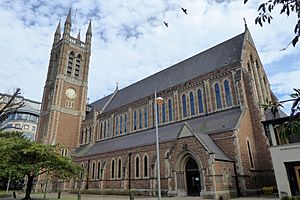St Paul's, Hammersmith facts for kids
Quick facts for kids St Paul's, Hammersmith |
|
|---|---|
| Church of Saint Paul, Hammersmith | |
 |
|
| Denomination | Church of England |
| Churchmanship | Evangelical |
| Administration | |
| Parish | Parish of Hammersmith (until 1965) |
| Deanery | Hammersmith and Fulham |
| Archdeaconry | Middlesex |
| Diocese | London |
| Province | Canterbury |
St Paul's is a historic Anglican church on Queen Caroline Street in Hammersmith, London. It is a Grade II* listed building, which means it is a very important building that is protected by law.
The church is located next to the Hammersmith flyover and is easy to reach from the Hammersmith tube station.
Contents
History of the Church
The First Chapel
In the 1600s, Hammersmith was a small village in the parish of Fulham. The main church for everyone was All Saints Church. However, as more people moved to Hammersmith, the journey to the church in Fulham became very difficult, especially in winter. The path was long, muddy, and sometimes even went across ploughed fields.
A New Place to Worship
In 1629, the people of Hammersmith, including a rich merchant named Sir Nicholas Crispe, asked the Bishop of London, William Laud, for permission to build their own chapel. They explained how hard it was to get to the main church. The Bishop agreed, and the community raised money for the new building. Sir Nicholas Crispe was the biggest helper, giving £700 and bricks.
The foundation stone was laid in 1629, and the new chapel was officially blessed and opened on June 7, 1631. It was named the "Chappel of Saint Paul."
Rules for the New Chapel
Before the chapel opened, an agreement was made to protect the rights of the main church in Fulham. The rules included:
- The people of Hammersmith had to pay for their own priest and keep the chapel in good repair.
- They still had to pay taxes and fees to the main church in Fulham.
- All weddings, baptisms, and funerals had to be recorded in Fulham's official register.
- The priest from Fulham could visit and hold services at the chapel whenever he wanted.
Famous Burials
Two important people were buried at the first chapel.
- Edmund Sheffield, 1st Earl of Mulgrave, who bought the land for the chapel, was buried there in 1646.
- Sir Nicholas Crispe, who paid for much of the building, was buried there in 1665. A monument was built for him that included a brass head of King Charles I. It also held Sir Nicholas's heart in an urn.
The Church We See Today
By the 1800s, Hammersmith was growing quickly, partly because of the new railway. The old chapel was now too small for the number of people living in the area. In 1834, Hammersmith became its own parish, and St Paul's became its official parish church.
In 1880, the community decided to build a bigger and better church on the same spot. They felt the old building was "unsightly" and not grand enough for an important London suburb like Hammersmith.
Building the New St Paul's
The new church was built between 1882 and 1891. It was designed by architects J. P. Seddon and H. R. Gough. The foundation stone was laid by Prince Leopold, the Duke of Albany, in 1882. The main part of the new church, called the nave, was opened in 1883.
Changes in the 20th and 21st Centuries
In the late 1950s, the church lost some of its land when the Hammersmith Flyover and the Great West Road were built. This land included some of the church's graveyard.
In 1983, the old wooden benches, called pews, were removed. They were replaced with chairs, which makes the space more flexible for different events.
More recently, a modern extension was added to the west end of the church. This new part includes a hall and a kitchen. The extension was opened in 2011 after a major restoration of the church.
Inside and Out
The Exterior
The church was designed in a style called Early English Gothic. It has tall, narrow windows, strong supports called buttresses, a high roof, and a large, impressive tower.
The Interior
The inside of St Paul's is very large. It is 58 metres long, 22 metres wide, and 19 metres high. It was originally built to hold 1,400 people.
The walls are made of a brown stone called Ancaster stone. The columns are made of beautiful Belgian marble. The arches are made of white and blue Bath stone.
The pulpit, a raised platform where the priest speaks, is very old. It came from another church in London called All-Hallows-the-Great, which was knocked down.
Stained Glass and Art
The beautiful stained glass windows were made by the famous company Clayton and Bell.
- The windows on the north side of the church tell the story of Saint Paul.
- The windows on the south side tell the story of Saint Peter.
There are also two very large, modern paintings by the artist Charlie Mackesy. One painting shows the crucifixion of Jesus, and the other shows the story of the Prodigal Son.
See also
- HTB network



